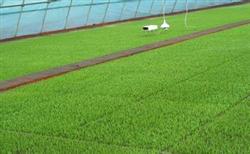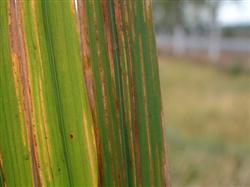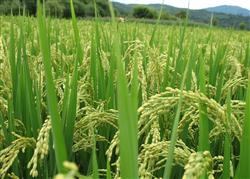Timely and early planting of rice is beneficial to increase yield.

Timely and early planting is an important link in rice cultivation, especially in multi-mature areas, the season is tight, but also to seize the opportunity to grasp this link, it seems to make full use of the suitable growing season of the year. Early planting at the right time is beneficial to early tillering and more tillering. At the same time, early planting can prolong the vegetative growth period of Honda after transplanting, increase the accumulation of nutrients, and facilitate the formation of large ears. According to the experiment, the early or late transplanting is closely related to the yield, and the complex regression equation is: Yizheng 593-4.22x (1)-4.48x (2). Y represents the theoretical yield, x (1) is% of the early planting area of Xiaoman in summer, and x (2) is the late planting area of the Summer Solstice accounting for% of the total rice area. There was a significant positive correlation between early planting area and per unit yield between the Beginning of Summer and Lesser Fullness of Grain (r = 0.8622). With the seasonal bill of lading, for every 1% increase in planting area, the average per unit yield of rice increased by 2.11kg. There is a negative correlation between the Summer Solstice's late planting area and rice yield per unit area (the Summer Solstice 0.8799), that is, when the late planting area of the Summer Solstice increases by 1%, the average rice yield decreases by 2.24kg, which shows the importance of timely and early planting. In addition, early planting can also be early maturing, favorable for timely sowing, to achieve high yield of two crops. Planting early at the right time depends on temperature, previous crops, varieties (combinations) and special animals. Temperature is the most important factor to determine whether to plant early. According to research, when the daily average temperature is 20 ℃, it will turn green in 4-6 days, 7-10 days at 15 ℃, and more than 10 days when it is lower than 15 ℃. When the temperature is lower than 15 ℃, early planting is not precocious, and sometimes the seedlings will die, which can not achieve the purpose of increasing production. If the planting is too late, the fruiting will be affected by low temperature (autumn wind) in the later stage, and sowing will be affected in the double cropping area, which all need to be paid attention to. Of course, in order to achieve early planting, it is necessary to consider the reasonable arrangement of stubble and varieties, which must be based on the overall situation and take care of each other, which is beneficial to the high yield of the season. When planting, it should be strictly required to be uniform, straight, shallow and stable, so as not to hurt seedlings as far as possible, reduce the rate of plant injury to a minimum, and improve the quality of planting. "shallow", that is, the planting should be shallow, generally no more than 3.3 centimeters, and the advantage of shallow planting lies in: it can make the root node in the shallow soil layer with higher ground temperature, which is beneficial to early and multiple roots and absorb a lot of nutrients; it can make the stem in the tillage surface layer with large temperature difference, promote early and multiple tillers, and form multiple spikes; it can fan out the plant, improve light energy utilization, rapidly expand leaf area, increase photosynthate, and lay the foundation for large ears. "uniform" means that the distance between rows and nests should be neat and uniform, the number of seedlings per litter should be the same, it is convenient for ventilation and light transmission, the nutritional area of each plant is balanced, and the whole field grows neatly. "straight" means that the seedlings should be upright, and the seedlings should not be planted, which is conducive to turning green. "steady" requires that the seedlings are not drifted after shallow planting. To reduce plant injury is to minimize root and leaf injury when pulling, transporting and transplanting seedlings. In order to achieve the above requirements, attention should be paid to: ① irrigation with deep water 1 or 2 days before pulling seedlings, less root injury when pulling seedlings, it is best to transplant seedlings with soil; when ② seedlings are tied up, the roots of seedlings are picked up; when ③ seedlings are planted, try their best to avoid "five-clawed seedlings", "decapitated seedlings", "turning roots" and "deep planting". ④ general field planting "muddy water seedlings" can be used to make good contact between sunken soil particles and roots, which is conducive to rooting and turning green, so there is a farm proverb that "it is better to plant overnight seedlings than overnight fields". Sha Tin should plant seedlings immediately after raking the fields. For the rotten fields with strong starching ability, it is required to plant "clear water seedlings", otherwise the seedlings will sink too deep due to the sinking of the soil, resulting in slow rooting, late return to green, few tillers and, in serious cases, "sitting".
- Prev

One-time fertilization technique for Rice
The distribution of rice bacterial leaf streak is referred to as rice fine leaf streak, which is one of the most important rice diseases in the world. The pathogen belongs to the genus Xanthomonas. Most of the pathogens invade from the stomata of leaves, and the disease can occur in any growth period of rice. The disease spot is a short and thin narrow spot, with stripes appearing between the veins of the leaves.
- Next

Effect of different ratio of fertilization on yield of Rice
The premature senescence of rice from heading to maturity will lead to poor grain filling, increase of blighted grain and decrease of yield. There are many factors leading to premature senescence in the later stage of rice growth. First, improper cultivation and management. The planting density is too high, the plant growth is weak; the early and middle stages of nitrogen fertilizer application, phosphorus and potassium fertilizer and trace element fertilizer application.
Related
- The first cup of black tea in spring, the flavor and history of tea gardens in Kenya, Africa
- The computer can not only choose potatoes, but also grow tea rice. AI will grow winter oolong tea champion.
- It is not only the inflated tea bitten by insects, but also engraved with the four seasons tea in Beipu.
- The Oriental Beauty Tea Festival in Zhuxian County takes the stage at the weekend to experience the plus-size feast of oil tea.
- & quot; Oriental Beauty Tea & Exploration of Emei in Hsinchu, the hometown of quot;
- The new variety of strawberry "Tainong 1" dessert is the first choice with mellow aroma. Crimson gorgeous
- History of Tea in Taiwan: from Wild Inner Mountain to Export Tea Garden
- Two types of Taiwan Oriental Beauty Black Tea won the British three-Star Award for Childhood Tea Xiang Zhang Jiaqi changed from pilot to champion tea maker.
- Banana species and varieties: the planting history of Taiwan Xianren banana and dwarf banana is long, is banana disease resistant?
- Coffee planting Technology: Qianjie Coffee from Seedling to harvesting

